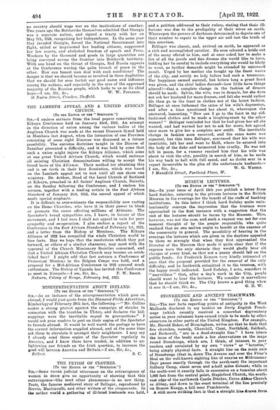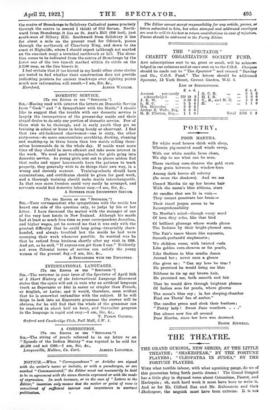STONEHENGE AND ANCIENT TRACKWAYIL [To THE EDITOR OP THE "
SPECTATOR."'
Sra,—The new facts regarding points of. antiquity in the West Midlands disclosed in my booklet on Early Enalish_ Track- ways (which recently received a somewhat deprecatory- notice in your columns) have caused trials to be made by other observers in other parts of the United Kingdom. For. example, Mr. Harold Baker, of Birmingham, writes me that he finds that five. churches, namely, Churchill, Cleat,- Northfield,. Solihull. and Berkswell,. " are in a dead-straight line." I have (since. the issue of the book) made a. few observation& on the maps round Stonehenge, which are, I think, of interest. to your readers and. untainted by my own. " views" or "heresies," being simply physical facts. A straight. line on the main. axis of Stonehenge (that is,. down. The Avenue and over the. Friar's Heel on- the well-known sighting line of sunrise en Midsummer Day) passes exactly through. (to the north-east) the important Sidbury Camp, about seven and a-half. miles distant; while to the south-west it exactly falls in succession on a tumulus about. 1,000 feet from -the central point, Stapleford. Church,. the south,. east edge of the earthwork Castle.Ditches, Cerne.Ahlma Church. or Abbey, and down to the eoast ter.minal of the line precisely on- Beacon Knapp, a hill near. Puncknowle.
more. striking fact is that a straight haw drawn. from
the centre of Stonehenge•to Salisbury Cathedral passes precisely through the centre (a mound I think) of Old Sarum. North- ward in:km. Stonehenge it lies on St. Ann's Hill (958 feet), just south-west of Silbury Hill. Southward from Salisbury it lies for abort a mile on the present road for Odstock, passes through the earthwork of Clearbury Ring, and down to the coast at Highcliffe. where I should expect (although not marked on the one-inch map) a terminal earthwork or hill. The direc- tion seems to be indicated from the centre of Stonehenge by the lower one of the two tumuli marked within its circle on the 1-2500 map, as the line bisects it.
I feel certain that if (as hinted in.-my book) other stone circles are tested to find whether their construction does not provide indicating pointers for ancient trackways over sighting points much new information will result.—I am, Sir, &c.,



































 Previous page
Previous page